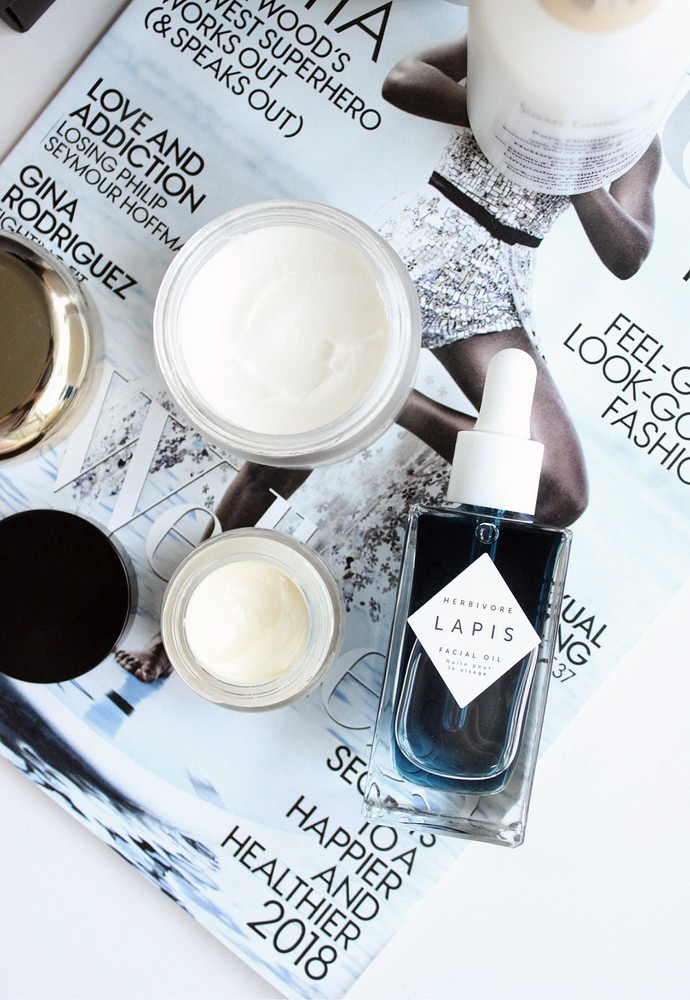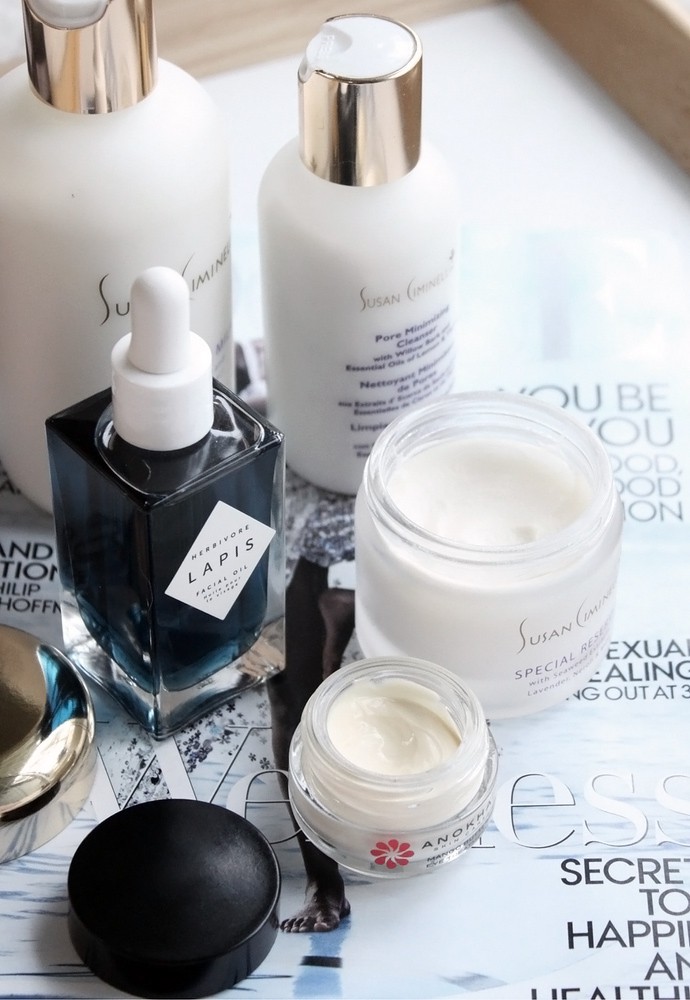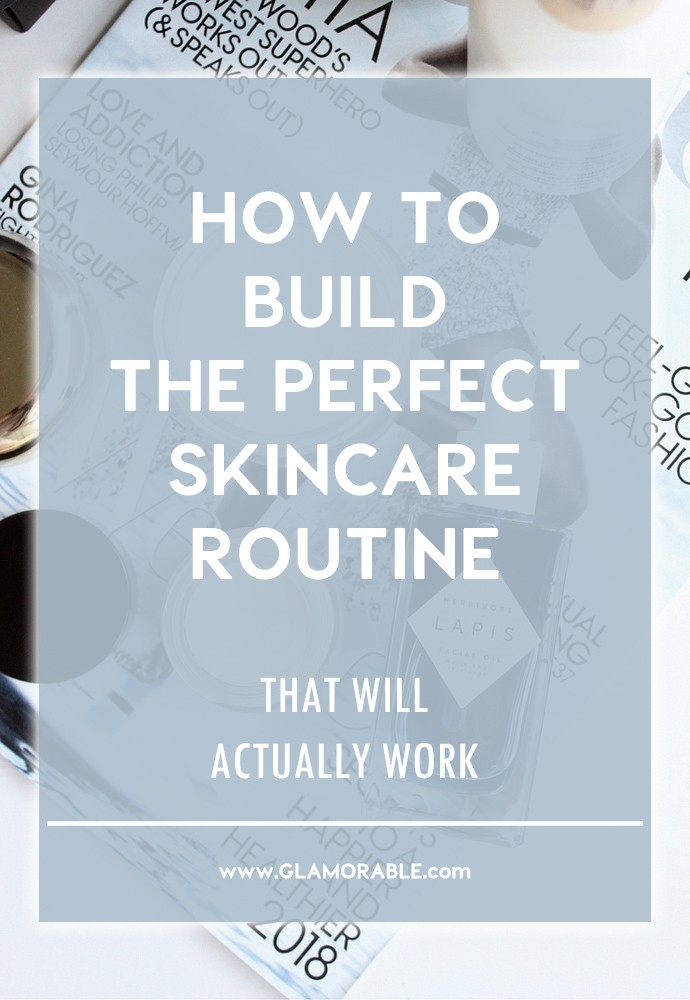How to Build the Perfect Skincare Routine for Every Skin Type and Concern
Have you ever walked into a beauty store to buy a moisturizer and felt totally overwhelmed with the options? Or maybe you have all that skincare sitting in the beauty cabinet, but you aren’t happy with the way it works. I know exactly how that feels as I’ve been there myself.
One of my New Year’s resolutions for 2018 is to share more skincare secrets and useful tips on this blog, as opposed to back-to-back reviews. Today I will be sharing how I navigate the confusing world of skincare ingredients and figure out what’s best for different skin concerns that most of us face from time to time. You guys know I’m not a professional or anything, but I’m very passionate about skincare and skin health in general, so I try to stay on top of the latest beauty releases and ingredient research. For the most accurate and up-to-date information you should talk to your licensed derm or an aesthetic professional.
With that said, here are the main beauty concerns that women try to address by using OTC beauty products.
ANTI-AGING:
When women look for anti-aging products, they usually hope to address one or several of the following concerns: lines, wrinkles, loss of elasticity, age spots, and skin sagging. Aesthetic medicine is currently the most effective way to correct those, but in this blog post we’re talking specifically about skincare you can use at home.
SPF // Unprotected sun exposure is easily the main cause of skin sagging, lines, wrinkles, and age spots. While UVB rays cause burns on the surface, UVA rays reach deep into the dermis and cause collagen to break down. Collagen is essential for keeping the facial contours intact, and helping the skin bounce back from frowning and smiling. Once collagen reserves are depleted, the skin can no longer bounce back, and the lines become permanent.
I grew up thinking that I only need to use SPF on sunny days or during the summer months, but recent research revealed that UVA rays are present in pretty much the same amounts throughout the year. UVA can penetrate through the clouds and glass, so we are getting the same amount of skin damage at the beach in July and walking the dog during a snowstorm in January.
Personally, I think that an SPF50+ physical sunblock with Zinc Oxide and Titanium Dioxide is the best choice out there, but any sunscreen is better than no sunscreen at all. While chemical sunscreen agents tend to cause skin irritations in some people, they are still a viable choice for people who don’t like to use physical sunblocks for one reason or another. Some also prefer products that contain both mineral and chemical agents in their skincare. Just make sure your sunscreen provides broad-spectrum protection, and you’re golden.
CURRENT ANTI-AGING FAVORITES
ANTIOXIDANTS // Along with unprotected sun exposure, free radicals are the main cause of collagen loss, age spots, and skin cell mutations. Free radicals form when otherwise healthy molecule bonds are broken by UV radiation, and an electron becomes loose. An unstable molecule then tries to capture the nearest healthy electron from another molecule to gain stability, causing a chain reaction that may eventually lead to cell death or mutations. Antioxidants are very special molecules that are stable in either form, so when a free radical steals one of their electrons, it ends the domino effect and prevents eventual cell death.
Vitamins C is considered to be the best water soluble antioxidant, and Vitamin E is the best fat soluble antioxidant. Other great ingredients to look for is Resveratrol and Ferulic Acid, both of which work especially well when used alongside the first two.
RETINOL // Retinol is a blanket term for Vitamin A and its derivatives. Retinoids come in different strengths and concentrations, but ultimately, all products containing a form of Vitamin A are considered anti-aging. Retinol is one of the most well-researched, tested, and trusted beauty ingredients with many skincare benefits. It’s been proven to reduce the depth and length of fine lines and wrinkles, unclog congested pores, and aid in collagen production [that last one is mostly due to its excellent antioxidant properties]. Retinoids generally need to be used for several months before you start noticing visible results.
Note: The way Vitamin A works as an antioxidant is a bit complicated, but long story short – it should always be paired with a broad-spectrum SPF product.
OILINESS:
Few people actually have oily skin, and it’s normally tied to genetics, hormones, lifestyle, stress, and environment. Most of us have normal or combination skin that went into oil-producing overdrive because we dry it out too much with alkaline cleansers, soap, astringents, toners, acne medication, etc. Every time you use a drying product, the skin will attempt to produce more oil as a defensive response.
CURRENT FAVORITES FOR OILINESS
Unfortunately, there isn’t much skincare can do to really help oily skin, except make it appear less oily. Your best bet trying to stress less and talk to a professional, especially if you suspect that it might be hormonal. On the other hand, people whose skin is not actually oily, but behaves like it, can expect to see noticeable improvements if they try the following:
LINOLEIC ACID // I went into more detail in this blog post, but the science behind this is simple. Beauty oils rich in Linoleic Acid help make the sebum thinner, helping unclog the pores without drying out the skin. Best in this category: grapeseed oil, seabuckthorn oil, pomegranate seed oil, safflower oil, evening primrose oil, poppyseed oil, hemp oil, rosehip oil, maracuja oil.
LOW PH CLEANSER // Alkaline cleansers are great at washing away the oil and give your skin that squeaky clean feeling. Problem is, along with the dirt and debris, they also strip away the skin’s protective acid mantle [alkaloids neutralize acids, remember that from science class?]. With its protective acid mantle gone, the skin turns to the second line of defense – oil. That’s why a lot of people who use high pH cleansers claim that they have oily skin. Here’s a great article from a fellow blogger on the importance of low pH cleansers and nurturing your acid mantle. Aim to use cleansers with pH between 5.0 and 5.5 when mixed with your tap water. Here’s the link to pH testing strips I use for my cleansers.
DRYNESS:
It’s not true that only dry skin needs hydrating ingredients; all skin types can become dehydrated at some point. The difference between dry and dehydrated skin is simple: dry skin lacks the occlusive oils necessary to seal in the moisture, dehydrated skin lacks the actual water.
Note: It was proven that drinking lots of water is great for your overall health, but most of that water goes to support the vital organs and very little of it actually reaches the skin.
There are three main types of ingredients that will help keep the skin smooth and hydrated:
HUMECTANTS // Humectants are a class of skin moisturizers that attract the water from the air and deeper layers of the skin into the epidermis. The best and most accessible humectants include Glycerin, Propylene Glycol, Sorbitol, AHAs, and Hyaluronic Acid. Problem with HA is that it’s too strong of a humectant, so when it doesn’t have enough moisture to draw from the air, it will draw a lot of it from your own skin, and may even cause dehydration, which is ironic. To prevent that, make sure to avoid using it in very dry environments, and always pair it with a good occlusive. Humectants are especially great if you have oily or combination skin.
CURRENT HYDRATING FAVORITES
OCCLUSIVES // Occlusives are a class of skin moisturizers that coat the skin like a blanket, preventing the moisture from evaporating. Some occlusives are considered to be comedogenic, because they coat a bit too well and are hard to remove with regular cleansers. It’s not really the ingredient’s fault, since it was just doing its job, but rather that nobody wants to spend 10-15 minutes on the cleansing step alone. Popular occlusives include Dimethicone and other silicones, Petrolatum, Evening Primrose Oil, Jojoba Oil. Occlusives are great if you have dry skin.
EMOLLIENTS // Emollients are a class of ingredients that fill the cracks in the epidermis, making the surface of the skin look and feel smoother. These are especially good for bringing comfort to dry, scaly skin. Technically speaking, both humectants and occlusives are also emollients. Effective emollients include essential fatty acids, Squalane, Coconut Oil, Shea Butter, Cocoa Butter, Lanolin, triglycerides, stearates, myristates, palmitates. Emollients are great for all skin types.
HYPERPIGMENTATION:
There are many types of hyperpigmentation, all manifested by increased melanin production in the skin. These three are the most common:
- Freckles and liver spots/age spots/sun spots are caused by unprotected sun exposure and genetics.
- PIH or Post-inflammatory hyperpigmentation is caused by inflammation and damage to the skin’s surface. This can be a result of strong chemical peels, trauma, or acne.
- Melasma is a skin discoloration that occurs in the dermis, and is usually caused by hormonal changes. Topical skincare products have little to no effect on this type of hyperpigmentation, and you will need to consult with a professional for personalized treatment options.
CURRENT HYPERPIGMENTATION FAVORITES
The best at-home treatment for fading the appearance of freckles, sun spots and PIH is a combination of a good sunblock, a resurfacing acid, and a melanin inhibitor. Popular melanin inhibitors include Kojic Acid, Azelaic Acid, Arbutin, Licorice Extract, Mulberry Extract, and N-Acetyl Glucosamine. Good resurfacing acids to look for are Retinoids, AHAs [especially Lactic Acid and 10%+ Vitamin C], and Mandelic Acid.
Fading hyperpigmentation takes a lot of time and effort, so it can get a little frustrating, but don’t give up! It usually takes 1-3 months of consistent product use to see the results.
DARK CIRCLES & PUFFINESS:
It even possible to get rid of dark undereye circles at home? The honest answer is no, but you can make them less noticeable by keeping the area moisturized, getting enough sleep, and resisting the urge to rub your eyes. It may lead to broken capillaries and make the situation worse. Using products that increase collagen production [retinoids, Vitamin C etc] can also help to a certain extent, but don’t expect miracles.
CURRENT EYE CREAM FAVORITES
Puffiness is usually caused by poor circulation and water retention, but other common causes include too much salt in the diet, lack of sleep, and genetics. Sleeping on your back, cutting back on sodium, using cooling skincare with caffeine, and keeping the area moisturized will help the skin look brighter and less puffy.
ACNE:
There are many types and causes to acne, some of which are best treated with help of a trained professional. In general, acne is often caused by bacteria that got stuck in the pore and caused inflammation. Some of the most effective OTC skincare for non-severe acne includes gentle soap-free foaming cleansers with pH 5.0-5.5, products with Retinol or Salicylic Acid to unclog the pores, and Sulfur, Benzoyl Peroxide or Tea Tree Extract to kill the acne-causing bacteria. Don’t forget to wear sunscreen to protect the newly exfoliated skin from discoloration and premature damage.
Note: Benzoyl Peroxide is a controversial ingredient, and I only use it as spot treatment.
CURRENT FAVORITE EXTRAS & ACNE CARE
EXTRAS:
This is where I like to experiment by adding non-essential ingredients. Don’t get me wrong, a lot of them are actually great for the skin, but if I was to strip the routine down to bare bones, they wouldn’t make the cut. Examples include peptides, fermented Eastern medicine botanicals, snail slime filtrate, trendy Centella Asiatica Extract, proprietary compounds, and stuff like that.
PERFECT SKINCARE ROUTINE:
As you might have noticed, some ingredients overlap here and there, which makes it even easier to create a routine to address multiple skin concerns at once. The lists below summarize how I currently build my AM and PM routines. The template stays pretty much the same throughout the year, even when I want to correct completely different issues.
AM:
- Cleanse – foaming cleanser with pH 5.0-5.5
- Hydrate – in the winter I like to use a hydrating toner topped with HA serum, Glycerin lotion, or both
- Antioxidant – either a Vitamin C serum, or a watery serum/essence loaded with botanicals
- Occlusive – I currently like products with Dimethicone and Ceramides, or natural butters and Jojoba Oil when I want to go a more natural route
- SPF – my skin has been sensitive lately so I’ve been trying to use physical sunblock instead of chemical ones
PM:
- Cleanse – micellar water for eye makeup, balm cleanser + washcloth, and foaming cleanser with pH 5.0-5.5
- Exfoliate/treat – I like to alternate between retinoids and AHAs, and also add a BHA toner to this step when I deal with breakouts
- Hydrate – HA in high concentration and hydrating toner
- Antioxidant – botanical serum, essence, or oil, and something with Vitamin E
- Repair – Korean sleeping packs or moisturizers that contain heavier occlusives
WEEKLY:
- Sheet masks – 2-3 times a week, just to keep the moisture level up
- Clay masks – I use them more often in the summer
- Acid peels – maybe once every 2 weeks or so, since I already include low percentage acids in my daily routine
- Cleansing brushes – I use Clarisonic Mia 2 or Foreo Luna once a week or less often to get a deep, thorough clean
It was hard to put something that doesn’t even have a concrete shape in my head, into words, but I’m glad I was finally able to summarize my thoughts and share my current skincare approach with you guys. I hope it can help some of you put things in order, just like it helped me. On that note, if you haven’t read it yet, check out this blog post where I captured my four year long battle with moderate acne and PIH that I totally won with help of Korean beauty products. It’s also one of the most pinned articles on my blog, thanks to all of you of course.
Do you think skincare is confusing? What are some of your favorite beauty products that you always keep coming back to? Let me know in the comments below!
Disclosure: I am not a trained beauty professional, the post above simply reflects my current skincare approach and philosophy.






I know I need to pay better attention to my skin. I’ve always thought I was oily until I had someone who knew what they were talking about tell me that I actually have super dry skin. Now it makes sense why some products worked for me and some didn’t. I also didn’t realize that I needed to exfoliate way more than I have been. I really love taking care of my skin – I just need to be better at it.
Exfoliating is helpful to your skin on so many levels! Figuring out what’s been missing in your routine is a great start.
You did a great job for this post. I like that you didn’t scrimp on details.
Thank you Kath!
Excellent post on skincare as always! But I want to add that for many women looking for anti-aging skincare, aesthetic medicine is out of reach for most because of the cost. And in addition to sun exposure, another cause of lines and wrinkles, lack of elasticity, sagging etc. is the decrease in female hormones due to menopause.
I absolutely agree, Allison! I wanted to mention aesthetic medicine to set realistic expectations. So many skincare companies brainwash women into believing their products work as well as aesthetic treatments, which is simply not true. But skincare is wonderful and can correct many things, and a lot cheaper than a med-SPA visit.
You always have the most informational posts. I’m bookmarking this for the future!
Enjoy the read!
Great informational post! I saved it to refer back to as needed.
Thank you!
This is such a good read! Thank you for sharing.
Happy to share!
quite an informative post!
Thank you! It was highly requested.
SO much great info!
Always happy to share
This is SUCH a useful resource – thanks for breaking down all those different components!
You’re welcome!
What a wonderful post! Thank you for sharing this!
Happy to share!
This is so helpful! And you touched on certain products I wouldn’t even have thought of to incorporate!
Thank you Miranda, I’m glad you found this helpful!
this is so helpful! It took me a bit to get a routine down for my combo skin!
Same here, it was a lot of trial and error
This post is amazing! So comprehensive yet easy to digest.
Thank you! I tried to make it easy to understand even for someone who is very new to skincare